Blossoms of Tradition and Modernity: Hiroko Imada at the Watts Gallery
27 September 2024
UCL VPEE Student Journalism Scheme student Caroline Coyer visits the Edo Pop: Japanese Prints 1825-1895 exhibition at Watts Gallery to explore the work of Slade alumna Hiroko Imada.

In a unique dialogue between the past and present, renowned artist and Slade School Alumni Hiroko Imada’s latest installation, Sakura saku (‘Cherry blossoms are blooming’), takes center stage at the Watts Gallery. As part of the Edo Pop: Japanese Prints 1825-1895 exhibition, Imada’s work skillfully intertwines the transient beauty of cherry blossoms with the timeless legacy of Japanese woodblock printing, blending age-old techniques with contemporary aesthetics to create a dynamic, immersive experience.
Hiroko Imada: Tradition and Innovation
Hiroko Imada is an internationally celebrated artist, best known for her expertise in Japanese woodblock printing. Born in urban Tokyo and moving to the countryside of Tokyo at the age of three, Imada's fascination with nature and movement became an early source of creative inspiration. From a young age, she was captivated by the ephemeral beauty of the natural world which would later become a hallmark of her work.
Her formal training began at Tokyo Zokei University, where she honed her skills in printmaking including traditional woodblock printing. Seeking greater creative freedom in London, Imada pursued further education at UCL’s Slade School of Fine Art. There, she became the first student to deeply explore Japanese woodblock printing in the UK, introducing British audiences to this ancient technique. She later returned to Japan to study the traditional skills of papermaking, folded screen making, and hanging scroll-making.
As a printmaker, Imada’s intricate woodblock process was filmed in her studio by the British Museum and The Queen’s Gallery — Royal Collection Trust for their exhibitions, offering audiences a step-by-step look inside traditional Japanese printing. In 2022, Dr. Martens commissioned her to create a woodblock print for their collaboration with the MET, inspired by Hokusai’s famous piece, The Great Wave off Kanagawa, a testament to the adaptability of this timeless craft. Universal Pictures also tapped into her talent as a painter, commissioning her to create a piece featured in Fast & Furious 9. As an installation artist, Imada created a monumental paper installation at Coventry Cathedral, merging her traditional techniques with the sacred space to create a powerful visual experience.
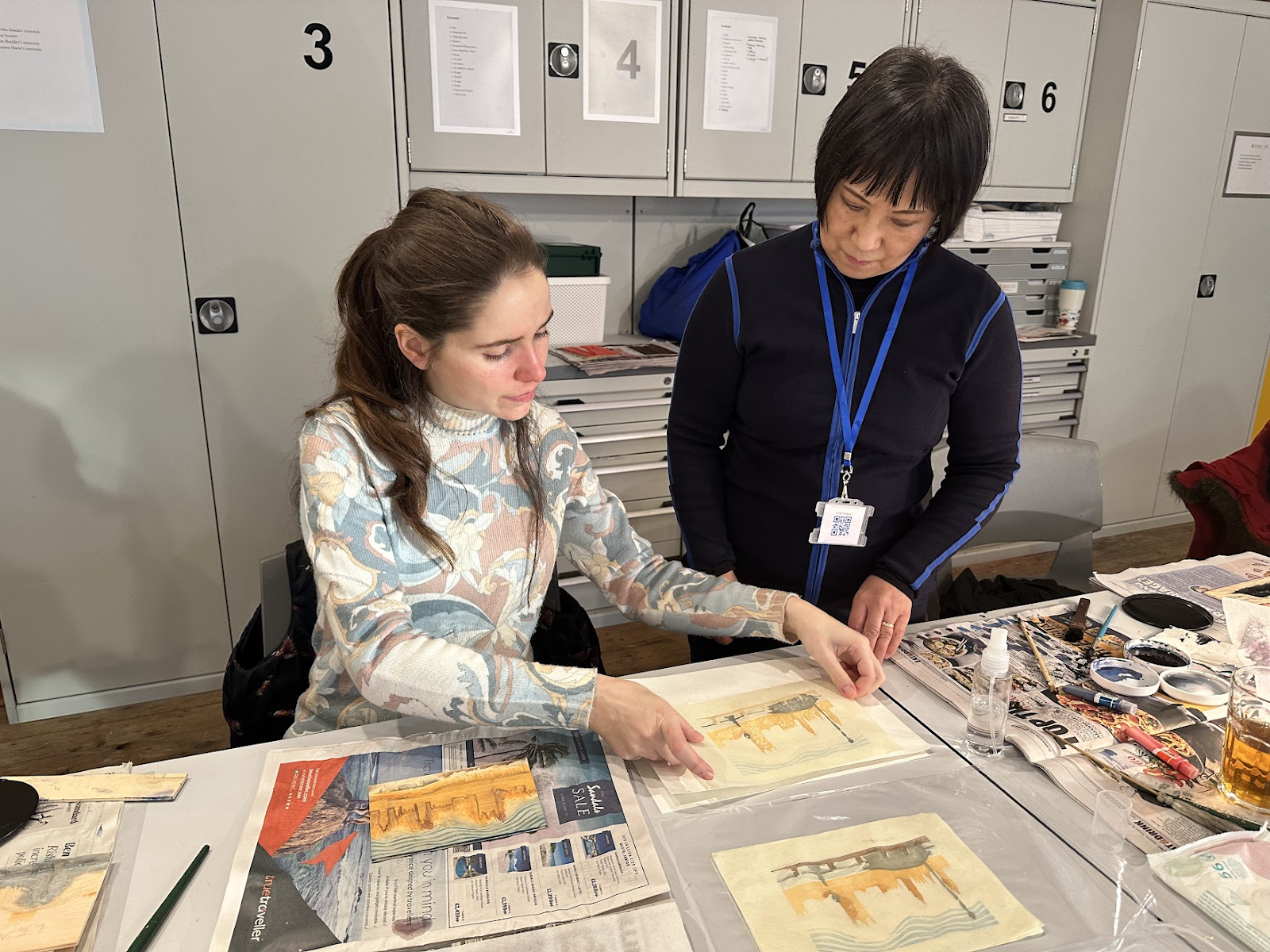 Imada’s workshop at the King’s Foundation School of Traditional Arts. Photo by Caroline Coyer.
Imada’s workshop at the King’s Foundation School of Traditional Arts. Photo by Caroline Coyer.
As an educator, Imada passes on these ancient techniques at prestigious institutions like the British Museum and the King’s Foundation School of Traditional Arts, revitalizing traditional forms using modern subjects and ensuring that Japanese art remains vibrant and accessible.
Her Sakura saku installation at Watts Gallery bridges her contemporary vision with the rich heritage of Japanese visual culture, bringing a slice of Japan right outside of London.
Watts Gallery: A Legacy of Art and Social Impact
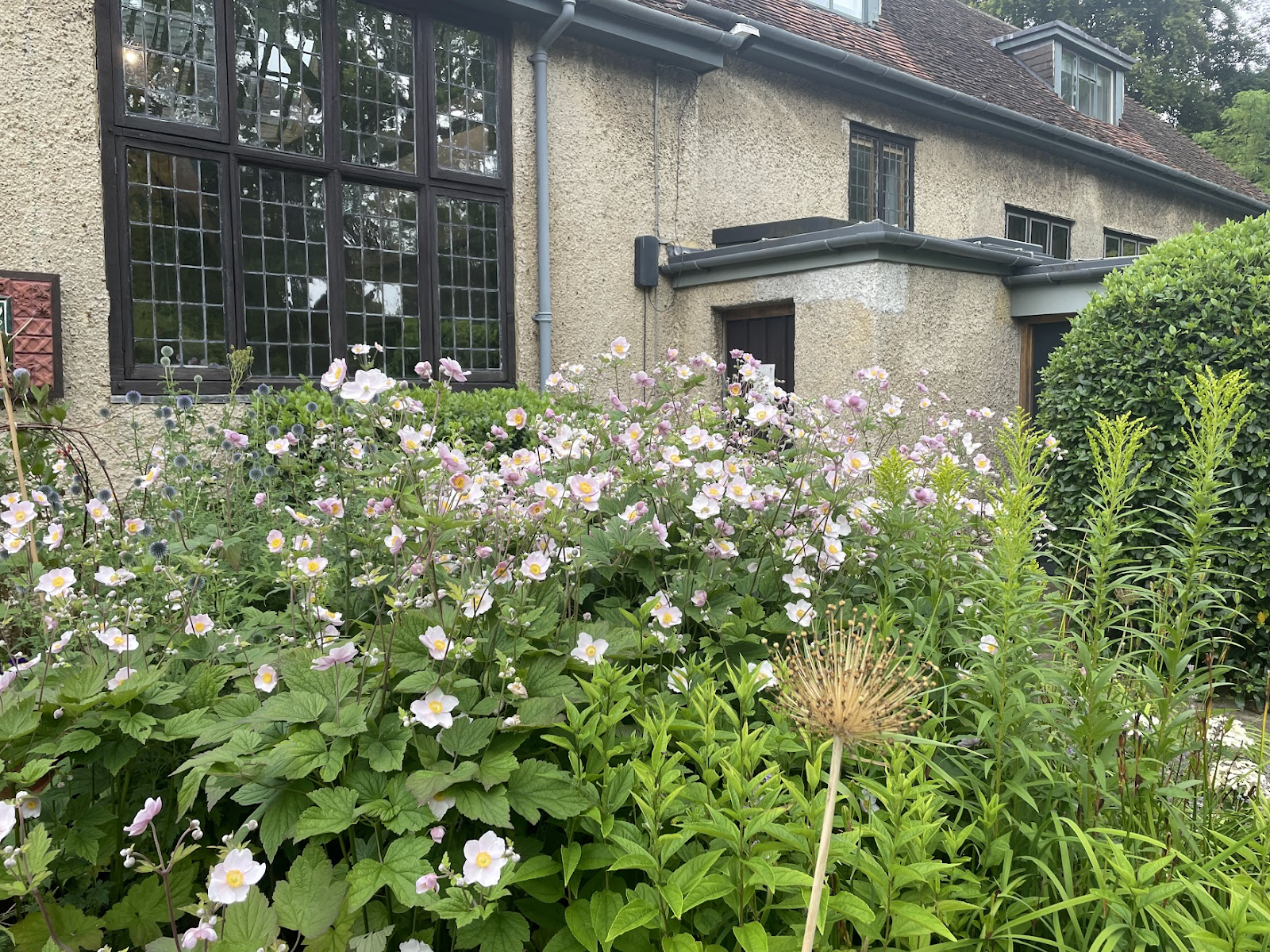 Watts Gallery flower garden. Photo by Caroline Coyer.
Watts Gallery flower garden. Photo by Caroline Coyer.
Nestled in the idyllic Surrey Hills, the Watts Gallery – Artists' Village was founded in 1904 to honor the legacy of Victorian artist George Frederic Watts and his wife, Mary Watts. The Wattses believed in the transformative power of art to create social change, envisioning a space where creativity would be accessible to all.
George Watts, often referred to as "England's Michelangelo," used his work to explore social themes such as the Irish Famine and animal cruelty, while also creating complex sculptures and Symbolist paintings rich in metaphor.
The gallery, initially dedicated to George’s work, has since grown into a vibrant cultural institution that also celebrates Mary’s contributions. Mary Watts was a gifted artist, designer, and philanthropist. She was the driving force behind the gallery’s community outreach efforts, using her creativity to uplift and inspire those around her.
Today, the Watts Gallery bridges its Victorian roots with contemporary art, juxtaposing historic works with modern pieces to create a dialogue between past and present. Community engagement remains central to the gallery’s mission, with programs like "Art for All" offering creative opportunities to marginalized communities. Through art, history, and outreach, the gallery carries forward the Wattses' vision of art as a transformative and unifying force.
Edo Pop curator and Head of Collections, Dr Laura MacCulloch, remarked, “This collection explores the great changes going on in a metropolis on the other side of the world during George and Mary Watts’s lifetime. We are delighted to have commissioned Hiroko Imada to respond to these prints and create new works for the exhibition, particularly as Imada, like Mary Watts studied at the Slade School of Art.”
Edo Pop Exhibition: A Glimpse into 19th-Century Japan
 Kuniteru II Utagawa (Kunitsuna II) (1830 - 1874), The New Shimabara Pleasure Quarter, Edo, 1869, colour print from woodblocks. Provided by the Watts Gallery.
Kuniteru II Utagawa (Kunitsuna II) (1830 - 1874), The New Shimabara Pleasure Quarter, Edo, 1869, colour print from woodblocks. Provided by the Watts Gallery.
Step back in time to the bustling streets of Edo (1604-1868), now known as Tokyo, through the lens of ukiyo-e, or "pictures of the floating world." Featuring over 50 19th-century Japanese woodblock prints, the Edo Pop: Japanese Prints 1825-1895 exhibition immerses visitors in the dynamic energy and rich cultural life of Edo's more than one million residents.
These bold, colorful prints capture everything from seasonal festivals and bustling street scenes to the lively entertainment district of Yoshiwara. Celebrity culture was central to Edo, with prints of kabuki stars, sumo wrestlers, geishas, and courtesans in high demand. Much like today’s posters of models, movie stars, and athletes, Edo residents collected these prints to celebrate their favorite icons, commissioning custom works to honor the famous figures of their time. Oiran, the highest-ranking courtesans, held significant influence, akin to today’s social media influencers.
Beyond the glamorous public scenes, these prints also revealed intimate glimpses of everyday life: a mother comforting her baby, or female divers searching for shellfish. Unlike the fine art they are seen as today, these prints were once distributed much like newspapers, affordable and accessible—costing about the same as a bowl of noodles. However, each image was meticulously crafted, sometimes requiring up to 100 blocks to layer colors and details. They brought the world of Edo to life on paper, long before the invention of photography.
As Imada pointed out, these prints also reflect Japan’s evolving relationship with the West. Largely isolated for much of its history, Japan was eventually forced open by Western powers, and this exchange began to permeate its art. “In some works, you can see the influence of Westernization, like a motor train or a young woman with a camera,” she explained.
Imada also drew attention to the use of vibrant blue hues in famous works, such as the very first editions of Hokusai’s prints. This striking color, Prussian blue, was imported from Germany and became highly popular during this period because it resisted fading under sunlight. This blend of East and West marks a pivotal moment in Japan’s history, where traditional art met global influences.
The Edo Pop exhibition is built around the remarkable collection of Frank Milner, whose decades-long fascination with ukiyo-e began with a spontaneous purchase on his way to buy a bottle of wine.
Reflecting on his passion for woodblock prints, Milner shared in an interview with the Watts Gallery, “They cheer me up. I love their modern feel, extremely bright colours, quirky perspectives... We forget that these are Victorian! To me, it seems no wonder that Van Gogh, Manet, Degas, Lautrec and other artists were completely bowled over when they first saw prints like these in the 1860s and 70s.”
His collection provides a rare glimpse into the cultural fabric of Edo, artfully showcasing the convergence of everyday life, fame, and striking traditional artistry.
Sakura saku: A Contemporary Take on Tradition
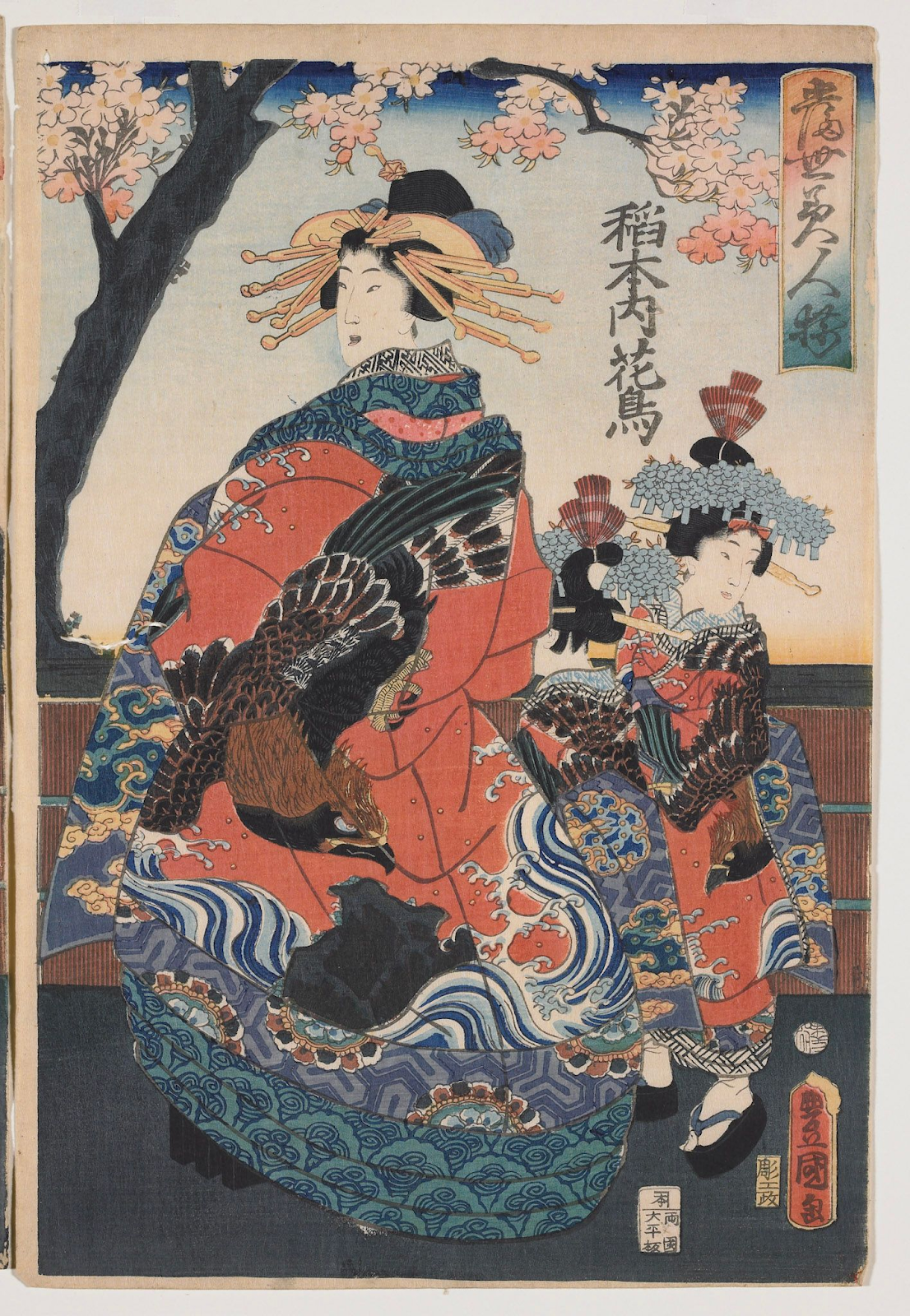
Utagawa Kunisada (1786 - 1865) 歌川 国貞, Three Senior Oiran on Parade in the Yoshiwara, Edo, (detail), 1853, colour print from woodblocks. Provided by the Watts Gallery.
Inspired by the traditional Edo-period prints on display, Imada’s installation Sakura saku (‘Cherry blossoms are blooming’) offers visitors a deeply personal and immersive experience. Cherry blossoms, or sakura, symbolize both new beginnings and the fleeting beauty of life—a theme central to many Edo-period woodblock prints and to Japanese culture itself.
“Cherry blossoms only last for about two weeks in Japan. They bloom so brilliantly, but their life is short. It’s a reminder that nothing lasts forever, but in those brief moments, the memory that stays with you is beautiful,” Imada reflected.
For Imada and many Japanese, cherry blossoms hold a deep emotional resonance. "Sakura has always carried a special meaning—linked to so many of my memories," she shared, recalling how the blossoms marked key life moments like the start of a new school year or graduations. This personal connection inspired Sakura saku, an homage to the historical, cultural, and emotional significance of cherry blossoms in Japan.
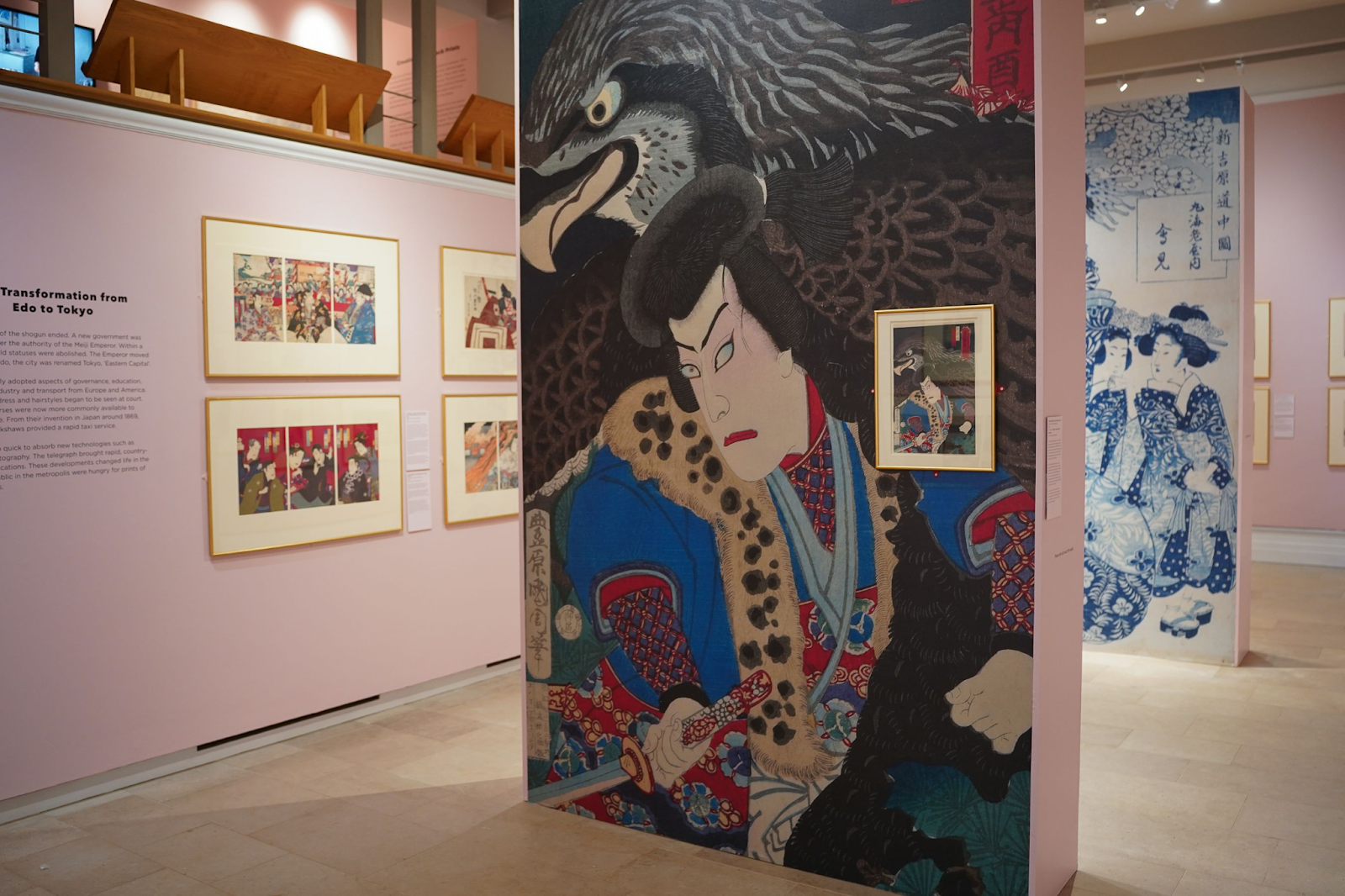 Edo Pop exhibition. Photo by the Watts Gallery Trust.
Edo Pop exhibition. Photo by the Watts Gallery Trust.
Drawing inspiration from the traditional ukiyo-e prints and the curator's pink palette, Imada used soft, vibrant hues to capture the delicate beauty of cherry blossoms, while incorporating abstraction to create a more contemporary interpretation.
The installation invites visitors to walk through suspended scrolls, experiencing the movement of blossoms that shift and sway, creating an ever-changing environment that echoes the fleeting nature of the flowers. Visitors feel as though they are strolling under a canopy of blossoms in full bloom.
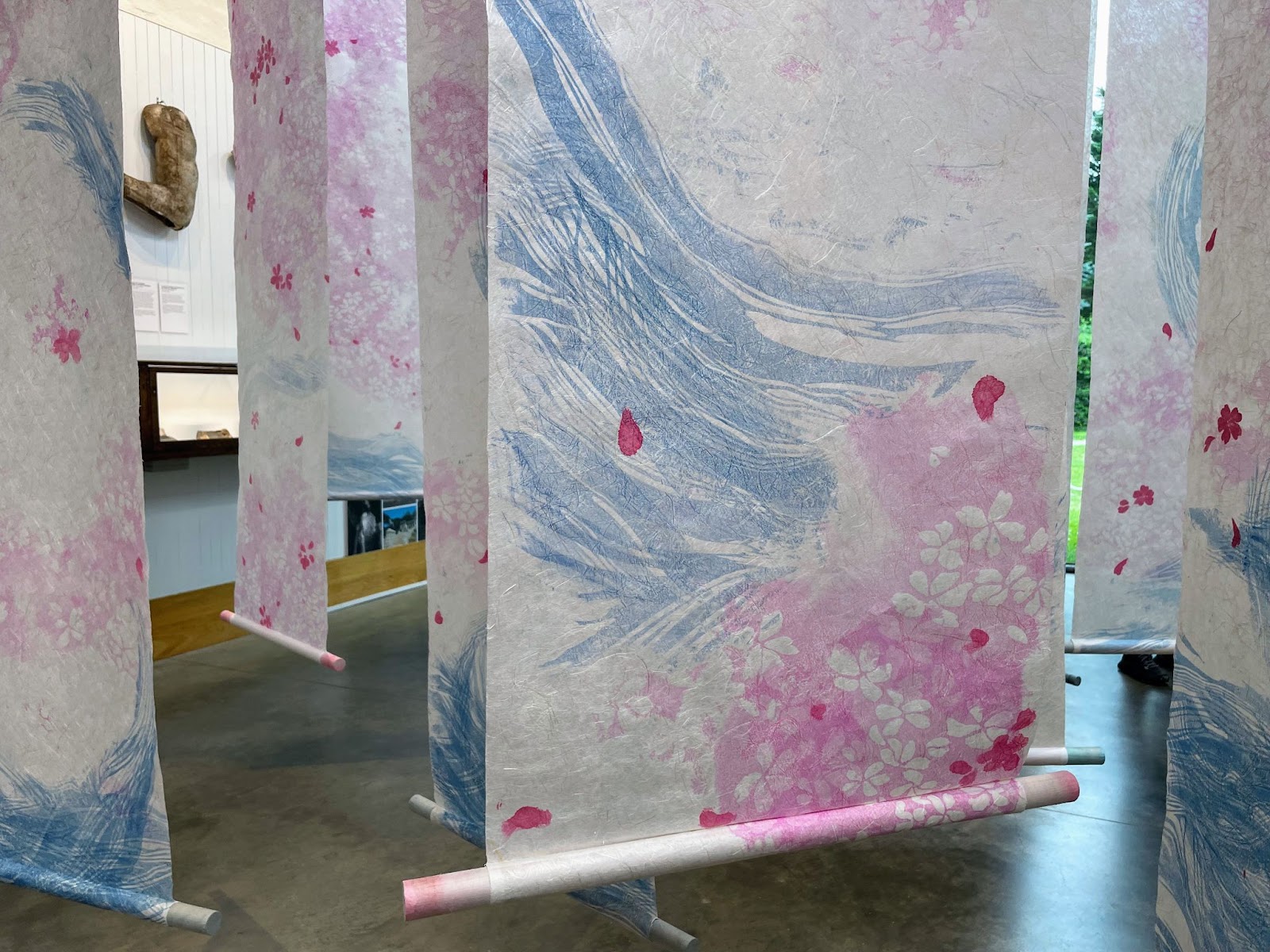 Sakura saku by Hiroko Imada at the Watts Gallery. Photos by Caroline Coyer.
Sakura saku by Hiroko Imada at the Watts Gallery. Photos by Caroline Coyer.
“Imada’s work brings a unique vibrancy to the Edo Pop exhibition. It’s accessible, immersive, and deeply reflective of the historical themes, making it a perfect complement to the Edo-period pieces,” said Olivia Parker, Head of Marketing at Watts Gallery.
Imada’s installation offers a modern-day hanami—the tradition of flower viewing—allowing visitors to celebrate the beauty of cherry blossoms right in the heart of Surrey.
 Visitors enjoying Sakura Saku at the Watts Gallery. Photo by Caroline Coyer.
Visitors enjoying Sakura Saku at the Watts Gallery. Photo by Caroline Coyer.
UCL and Japan: A Blossoming Legacy
During the Edo period, while woodblock prints flourished, UCL was forging a significant connection with Japan. In 1863, five samurai known as the Chōshū Five became the first Japanese students to study at UCL. Smuggled out of a closed Japan, they studied under Professor Alexander Williamson, with Itō Hirobumi eventually becoming Japan’s first Prime Minister. The first Japanese students to study abroad, the Chōshū Five played key roles in Japan’s modernization, contributing to its transformation in governance, education, and finance.
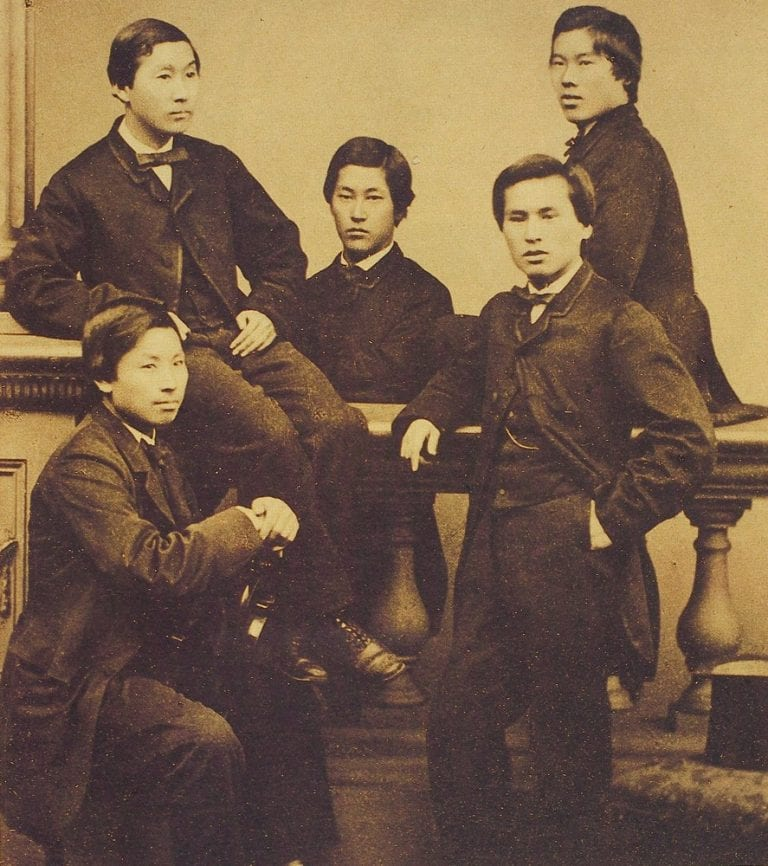
Chōshū Five, Photo from UCL.
UCL honors this legacy through its Japanese Garden outside the Student Center. There stands the Japan Monument, flanked by cherry blossoms donated through the Sakura Cherry Tree Project. The haiku inscribed on the monument, "When distant minds come together, cherries blossom," symbolizes the enduring friendship between UCL and Japan—a fitting parallel to Imada’s Sakura saku installation.
Hiroko’s Legacy and Artistic Contributions
Reflecting on her creative process, Imada shared, “If people see my art and feel happy or mesmerized, that’s a success for me. Art should bring joy. When I’m making art, I want to feel happy, and I hope others can find that same peace and happiness in my work."
This sentiment resonates deeply in Sakura saku, where visitors are invited to walk through a space imbued with the tranquility and joy that Imada pours into her work. Much like UCL’s legacy of fostering cultural exchange, Imada’s art bridges the past and present, celebrating the enduring beauty of cultural harmony.
For anyone eager to bring their own creative visions to life using Japanese woodblock printing, Imada's upcoming intensive course at the King’s Foundation School of Traditional Arts offers the perfect opportunity. Whether you're an absolute beginner or an experienced artist, the course provides Imada’s expert guidance while allowing you to work with traditional Japanese tools and materials. Imada offers a variety of adult courses, so you can build your skills at your own pace, starting with black and white and then adding color. This course starts Wednesday, October 2nd—don’t miss the chance to explore this timeless art form!
Gallery Information & Exhibition Dates
The Edo Pop: Japanese Prints 1825-1895 exhibition runs at Watts Gallery from 19 March to 6 October 2024. Experience these exquisite 19th-century woodblock prints alongside Hiroko Imada’s immersive contemporary installation, Sakura saku.
For those unable to experience the beauty of Sakura saku in person, the Watts Gallery’s video captures Imada’s detailed artistic process of creating cherry blossom-inspired scrolls.
For more information and to plan your visit, please visit the Watts Gallery website.
 Close
Close

